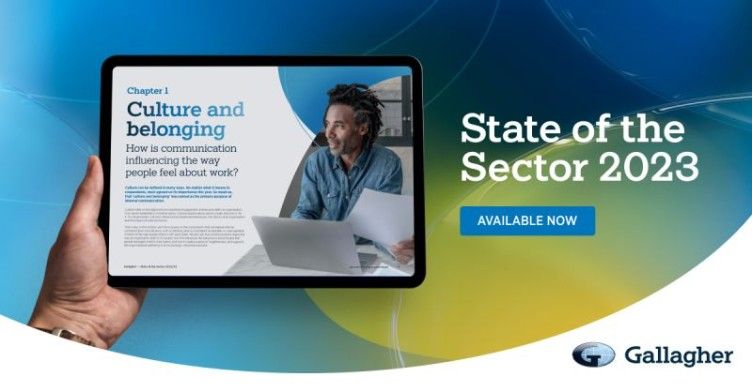What does Gallagher’s State of the Sector 2023 report say about the state of EX?

Lee Smith
Minutes
21 Jun 2023
Employee Experience
Way back in 2008, during the last financial crisis and in the early days of our fledgling internal comms agency, Gatehouse, Simon Wright and I hit on an idea. Those were dark days and consulting work was drying up at an alarming rate, so we had plenty of time to think. Why don’t we use our downtime to deliver some insight to the wider profession? Both passionate about the progression of internal comms and frustrated by the lack of any regular, reliable insights on the emerging profession, we decided to do something about it.
The result was the very first State of the Sector report.
The result was the very first State of the Sector report.
Looking back at that debut report now, it’s incredible to see how far it’s come in the 15 years - and 15 editions - since. It was a decent first effort, but a long way from the 60-page, insight-rich, global report you see today.
The original idea was to focus on sectors, hence the name, and that debut report was limited to the world of professional services. We quickly realised, however, that there was a much greater need for this insight - so we swiftly broadened it out to include all types of organisation and it quickly grew to become the most authoritative annual report in the IC space.
Fast forward 15 years and, now under Gallagher’s leadership, State of the Sector is still going strong. Indeed, Ben Reynolds and the team there have done a fantastic job over the last few years at broadening out the research, making it even more global in its focus, winning the support and backing of even more of the biggest names in the field, interpreting and analysing the results and, most importantly, giving it the sort of exposure it needs to influence practitioners worldwide. It’s a legacy of which I’m proud and I’m grateful to Gallagher for their stewardship of it over the last five years.
So, with a sense of pride and a little trepidation (there’s no denying some of the findings remain rather depressing!), I always look forward to reading and pondering the annual results.
The original idea was to focus on sectors, hence the name, and that debut report was limited to the world of professional services. We quickly realised, however, that there was a much greater need for this insight - so we swiftly broadened it out to include all types of organisation and it quickly grew to become the most authoritative annual report in the IC space.
Fast forward 15 years and, now under Gallagher’s leadership, State of the Sector is still going strong. Indeed, Ben Reynolds and the team there have done a fantastic job over the last few years at broadening out the research, making it even more global in its focus, winning the support and backing of even more of the biggest names in the field, interpreting and analysing the results and, most importantly, giving it the sort of exposure it needs to influence practitioners worldwide. It’s a legacy of which I’m proud and I’m grateful to Gallagher for their stewardship of it over the last five years.
So, with a sense of pride and a little trepidation (there’s no denying some of the findings remain rather depressing!), I always look forward to reading and pondering the annual results.
The state of EX
I was particularly interested to explore the insight around employee experience this year and, crucially, the role internal communication plays in influencing and enabling it.
First, it’s important to stress that the main focus of State of the Sector is and always has been internal communication. But that doesn’t mean it’s limited to insights around channels and content, far from it – from the get go we wanted to survey practitioners on the more strategic aspects of IC, including its role as an enabler of engagement, and I’m delighted to see that has continued.
So what does State of the Sector tell us about the state of EX? Here are some of my key takeaways:
First, it’s important to stress that the main focus of State of the Sector is and always has been internal communication. But that doesn’t mean it’s limited to insights around channels and content, far from it – from the get go we wanted to survey practitioners on the more strategic aspects of IC, including its role as an enabler of engagement, and I’m delighted to see that has continued.
So what does State of the Sector tell us about the state of EX? Here are some of my key takeaways:
- There is no doubt in my mind that many internal communicators are already directly involved in aspects of EX, particularly here in the UK, and this is clear from the data.
- Overall, 74% of respondents identify the purpose of IC as being ‘to create an inclusive workplace where employees feel valued and engaged’ – in other words a focus on culture and belonging, a key element of the wider employee experience.
- All the way through the report we find evidence that IC practitioners are focused on communicating themes that are important from an EX perspective (vision & purpose, DEI, ESG, values & behaviour, benefits & reward, employee recognition…) and many are also involved in activities that directly support it (delivering workshops and events, driving volunteering, social events, employee listening, culture change, personalisation and more).
- There is plenty of evidence from the report that organisations are beginning to embrace EX too – 72% of respondents say EX is now being discussed at the top table (though only a third say there is a clear mandate around this). This alone suggests that IC practitioners need to at the very least develop their understanding around EX and how to do it (don’t worry, The EX Space will soon be here to help!)
- Organisational listening, a critical driver of engagement and a core element of a positive employee experience, is a key part of the internal comms mix. Nine ‘listening channels’ are in use by more than a third of respondents and and 84% believe their organisation values employee feedback.
- Overall, 57% of respondents say their organisation has taken steps to revisit its employee value proposition in the last 12 months. Given the escalating war for talent and high levels of attrition, this is a positive sign that organisations are beginning to respond by rethinking the employee/employer relationship.
So there are lots of positive signs.
Of course, if we adopt a glass half empty rather than glass half full view of this, there are many, many areas for improvement too:
Of course, if we adopt a glass half empty rather than glass half full view of this, there are many, many areas for improvement too:
- The stats around personalising communications are grim - only half of internal communicators can address an employee by name and less than half can target by age or life event. And a depressing one in ten use audience profiles or personas to better understand their audience. The ‘one size fits all’ approach this underlines runs counter to everything we know about creating great employee experiences – and it’s time we started treating employees like humans (rather than resources).
- More than a third of organisations (36%) don’t communicate about ESG at all. We know that an organisation’s environmental, social and governance performance is hugely important to employees, so this is a major own goal.
- Diversity, equity and inclusion (DEI) scores better as the second most communicated topic this year, but just four in ten respondents report having a clearly defined strategy around it. This suggests DEI comms is a tick-box exercise for many – a theme organisations feel compelled to communicate even when they don’t have a clear stance on it.
- More than a third of respondents (34%) still view people managers as a cascade channel! Oh dear. Line managers are a critical piece of the employee engagement and experience equation – they are key enablers and need the support of IC to be equipped to do the job they need to do.
- Less than half of respondents report having a robust process in place for capturing employee insights and feedback. Too many organisations are still paying lip service to listening, another key enabler of great experiences and unlocker of engagement.
- When asked about employee’s understanding of what’s in it for them (pay, reward, benefits) a fraction over half rate this as good or excellent, and for career opportunities only a third do. We need to do a lot better at communicating why employees should work for an organisation and, importantly, why they should stay.
There are many more gems in there, both positive and negative, so I urge you to download the report and take a closer look.
The overarching theme for this year’s State of the Sector report is ‘Recalibrating internal communication’ and this seems like a sensible call to action. With the pandemic behind us, internal communicators can finally move beyond a focus on channels and content and start to make a tangible difference to the wider employee experience.
There are some positive signs that the profession is beginning to wake up to this challenge, but at the same time there are numerous areas where practitioners can and must improve. Internal communication is a key part of employee experience and IC professionals are superbly placed to be able to positively influence it and more – so I agree it’s time to recalibrate IC, towards EX.
The overarching theme for this year’s State of the Sector report is ‘Recalibrating internal communication’ and this seems like a sensible call to action. With the pandemic behind us, internal communicators can finally move beyond a focus on channels and content and start to make a tangible difference to the wider employee experience.
There are some positive signs that the profession is beginning to wake up to this challenge, but at the same time there are numerous areas where practitioners can and must improve. Internal communication is a key part of employee experience and IC professionals are superbly placed to be able to positively influence it and more – so I agree it’s time to recalibrate IC, towards EX.

